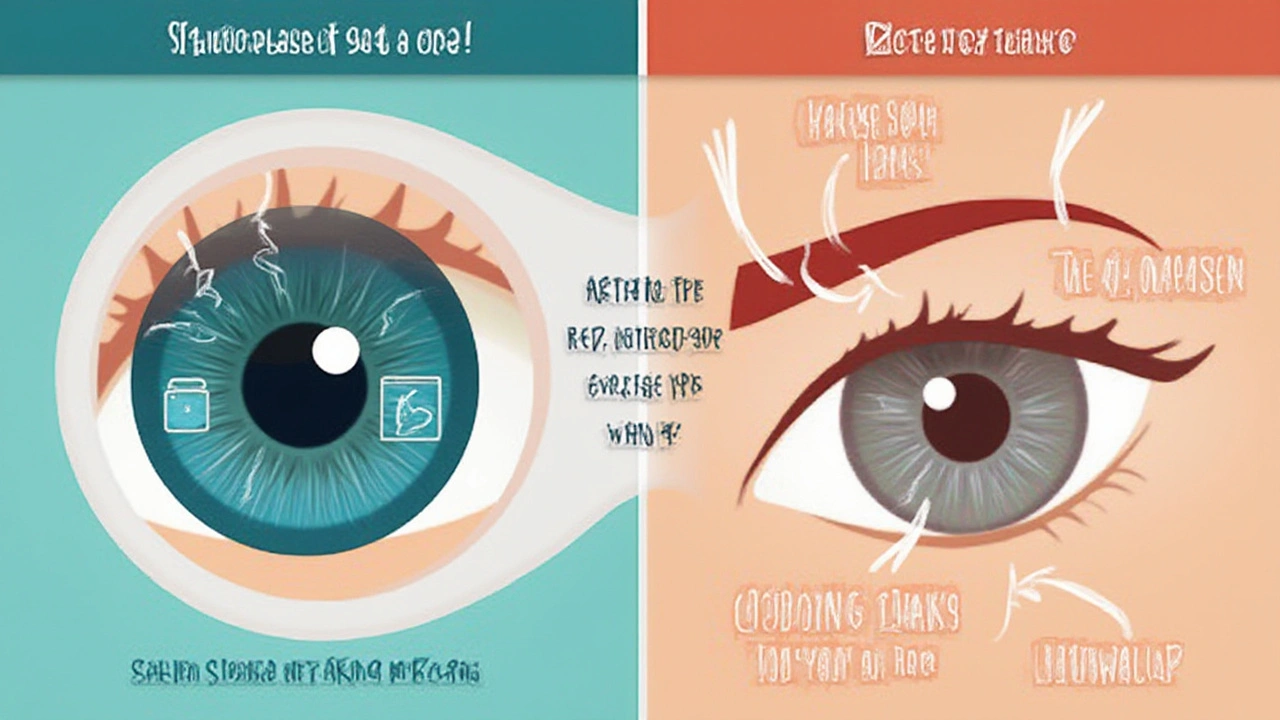Imagine popping open an unassuming little bottle that could make a meaningful difference in your eyesight—or give you dramatic lashes for days. That’s Bimat for you. This solution, whose main kicker is Bimatoprost, first hit the market as a sight-saver for folks fighting high eye pressure, but then beauty gurus and millions worldwide spotted its unexpected side effect: longer, fuller lashes. Suddenly, an eye medication became a must-have in vanity cases. That kind of pivot doesn't happen every day.
What Is Bimat and Why Does It Matter?
Bimat, sometimes called by its full ingredient name Bimatoprost, is an ophthalmic solution. Doctors have been prescribing it for years when someone gets news about high intraocular pressure, which is a fancy way of saying their eyeballs are clocking in with more pressure than they should. Left unchecked, that’s how glaucoma starts—and glaucoma, if left unchecked, is a major cause of blindness worldwide. Bit of a heavy start, but hey, let’s get honest about why people care about this tiny bottle in the first place.
Bimat works by helping the fluid in your eye drain out better, dropping that pressure back to safer levels. The numbers are striking: according to the World Health Organization, more than 76 million people live with glaucoma today, and doctors estimate that Bimatoprost-based drops have changed outcomes for millions who would otherwise lose their sight. The medicine is so effective that it was included on the World Health Organization’s List of Essential Medicines. Now that’s a flex.
Beyond sight, there's the story everyone whispers about online—the "Bimat lash effect." When people used Bimat drops, researchers and users alike noticed something: the solution didn’t just help eyes. It made eyelashes longer, too. The U.S. FDA eventually cleared Bimatoprost under the brand Latisse for cosmetic lash growth. Today, you’ll find beauty forums buzzing about Bimat as the secret behind thick, movie-star lashes. Crazy how science sometimes stumbles onto glamour, right?
So, if you’re here out of medical need or curiosity about gorgeous lashes, you’re in good company. The story of Bimat isn’t just for those reading tiny print on bottles—it’s about real life, real health, and a little serendipity too.
How Does Bimat Work in Eyes—and on Lashes?
The human eye is like a little city: so much going on, so many pressures at play (literally). Bimat comes in as a prostaglandin analog. That means it mimics stuff already found in your body—specifically, it acts like your natural prostaglandins to help more fluid leave your eye, reducing pressure. The less pressure, the less risk to your optic nerve, and that’s the real battle when it comes to keeping your vision sharp and clear as you age.
If you’re someone who likes numbers, consider this table:
| Use | Outcome Rate | Study Example |
|---|---|---|
| Eye Pressure Reduction | Up to 30% | Ophthalmology review, 2021 |
| Eyelash Length Increase | ~25% average | FDA trial, 2008 |
| Common Side Effects | Redness (up to 40%) | BMC Ophthalmology, 2019 |
When you apply Bimat for glaucoma, a drop goes in the eye, usually at night. For lashes, it's brushed along the upper eyelid (careful not to get it into the eye, even though it’s made for it—ironic, right?). Within weeks, you can see fuller, longer lashes, but the official word is that daily use for at least two months is what gives that wow.
Ever wonder why it doesn’t thicken your lower lashes too? Eyelash growth is mostly a result of how frequently each hair follicle is triggered—Bimat only affects the areas you apply it to. It’s one of those exact sciences. So, if you want more flutter, don’t expect a miracle in spots where you skip the brush.
This solution isn’t magic, but it’s pretty close to a double-duty tool. It is not a one-and-done, though. Stop using Bimat, and within about six to eight weeks, those "new" lashes will shed, and your growth patterns return to normal. Eyes, on the other hand, can see reduced pressure as long as you keep up daily use. It’s a commitment, not a quick fix.

How Safe Is Bimat? What You Need to Watch For
You’d think a bottle trusted by both eye doctors and beauty lovers would be worry-free. Well, Bimat does have its quirks. Most people handle it just fine, but there are some things you should know before jumping in headfirst.
The most common complaint is temporary redness or a bit of itching right after using the drops. For most, it fades in a few minutes and doesn’t last. Some users notice gradual darkening of the skin where they apply—so if you brush it on your lids every night for months, your upper lid could tan just a smidge. Eye color change is another talked-about side effect. If you have light eyes (blue or hazel), there’s a small, real risk your iris could darken permanently. Brown-eyed folks? No worries on that one.
Long-term use is safe for the vast majority of people. Still, serious stuff—like swelling, pain, changes in vision, or allergic reaction—warrants a stop and a call to a doctor. Never share your bottle, either. Even though it’s doctor-prescribed for glaucoma, sharing drops can spread bacteria and fungus. Think of Bimat like a toothbrush: private business only.
Don't forget the cost side of things. Without insurance, a little bottle of brand-name Bimatoprost can be pricey in some countries, sometimes crossing $100 per month. There are generics out there (like Bimat), but always check your supplier and make sure you’re getting the real deal, especially if you’re ordering online. Cheap knock-offs don’t just fail to work—they can be unsafe.
Pretty much everyone with eye issues or who wants thicker lashes can use Bimat, except pregnant women, breastfeeding moms, children under 16, and anyone allergic to the ingredients. Always check with an eye doc if you’re unsure—especially if you take other medications for your eyes.
Tips and Best Practices: Getting the Most from Bimat
Minuet, my little Siamese cat, wouldn’t notice if I swapped her eye drops (she’d just flick her ears and stalk away), but humans aren’t so lucky. Here’s what you need to keep in mind if you’re thinking of adding Bimat to your eye health or beauty routine:
- Use a clean brush or applicator—never reuse the same swab for both eyes.
- Wash your hands before and after application.
- If you wear contacts, take them out before applying, and wait at least 15 minutes before putting them back in.
- Don’t apply to lower lash lines—it bumps up the chance of irritation and uneven hair growth.
- Apply drops at the same time each day for best results.
- If you miss a dose, just use it the next time—don’t double up.
- Store the bottle at room temperature, out of sunlight, and always keep the cap tightly closed.
- Track expiration dates. Old solution can harbor bacteria. Time to toss if you see any clouding or color change.
- Book eye pressure checks regularly if you use Bimat for glaucoma.
- See an eye health pro if your eyes hurt, your vision changes, or you have unexplained symptoms.
People who misuse Bimat—like slathering it everywhere or using twice as much to get double the results—are only upping their risk for irritation. Patience actually wins here. For that rich-lash effect? Stick with it for at least eight weeks before you expect a full bloom.
Some users also add a little moisturizer under their lash line to combat any dry skin during use. If you’re flirting with both tubes of mascara and Bimat, it’s smart to wait till the solution dries before putting on makeup. Give your routine a little breathing room.

Interesting Facts and What Science Says About Bimat's Potential
Bimat didn’t start out as a beauty product, and yet, here we are. It’s a real study in medical side effects turning into global trends. Here are some tidbits that might surprise you:
- Bimatoprost is being researched for hair regrowth on the scalp—early trials look promising, but it’s not at your local drugstore yet.
- This drop was one of the first glaucoma medications shown to work just as well—sometimes better—than surgery for lowering eye pressure in mild cases, according to a JAMA Ophthalmology review.
- People who use Bimat for years report no increase in eye infections or severe side effects compared to other meds, according to a 2021 European glaucoma study.
- The most frequent cosmetic users of Bimat (or "Latisse") are women over 35, though men are catching up—especially with post-chemo hair regrowth interest.
- Bimat’s lash-enhancing effect is due to lengthening the growth phase of lashes. Each eyelash has a cycle, and Bimat tricks it into sticking around a little longer before falling out.
If you chat with an ophthalmologist, they'll often mention that patients are more likely to stick with Bimat than almost any other glaucoma drop, probably because the side effects are mild and that whole lash benefit feels like a little reward. Even better? Studies show Bimatoprost has a very low risk of developing resistance over time, so it works even after years of use.
There’s fresh research looking at using Bimat for other eye conditions—like ocular hypertension in kids (under close supervision)—and at different dosages for new beauty applications. The lesson here? Science is always learning, and just when we think we know a medicine, it shows us something new.
So whether you’re drawing careful lines for dramatic lashes or keeping your eye pressure in check, Bimat keeps proving its worth. Treat it right, respect its power, and never underestimate what a single drop can do.






Travis Freeman
24 July, 2025 . 11:12 AM
Bimat is wild how one little bottle can do so much-save sight AND give you lashes that look like you paid a fortune at the salon. I’ve been using it for glaucoma for two years now and honestly? The lashes are just the cherry on top. My wife says I look like I’m always winking at people. 😄
Sean Slevin
26 July, 2025 . 06:07 AM
So… let me get this straight… a drug designed to prevent blindness… accidentally became the most popular cosmetic in the world… and now we’re all using it like it’s mascara? I mean… that’s like if insulin made your hair grow back… and suddenly everyone was injecting it just to look younger… and no one even mentioned the fact that you might die if you didn’t use it for diabetes… it’s beautiful… and terrifying… and kinda poetic…? Like… science doesn’t care about your aesthetic… but it gave you one anyway…
Chris Taylor
26 July, 2025 . 23:55 PM
My mom’s been on Bimat for glaucoma since 2018. She didn’t even know about the lash thing until her hairdresser asked if she got extensions. She was like, ‘No, I just put drops in my eyes every night.’ Now she’s got the longest lashes in her bridge club. She says it’s the only thing that makes her feel like she’s winning at aging. ❤️
Melissa Michaels
28 July, 2025 . 17:36 PM
It is important to note that Bimatoprost should only be used under medical supervision. While the cosmetic benefits are well documented, the potential for permanent iris pigmentation changes, particularly in individuals with light-colored eyes, requires careful monitoring. Always consult with an ophthalmologist before initiating treatment, and never use non-prescription or unverified sources. Safety must come before aesthetics.
Nathan Brown
28 July, 2025 . 23:25 PM
Every time I see someone gushing about their ‘Bimat lashes’ I wonder… how many of them even know what they’re really applying? We treat medicine like a beauty hack now… like it’s just a tool for vanity… but it’s not. It’s a molecule that rewires biology. I’ve got a cousin who went blind from skipping doses because she ‘didn’t need it anymore’-she thought the lashes meant the pressure was gone. It broke my heart. So yeah… I’m glad you got the lashes… but don’t forget the eyes. 🙏